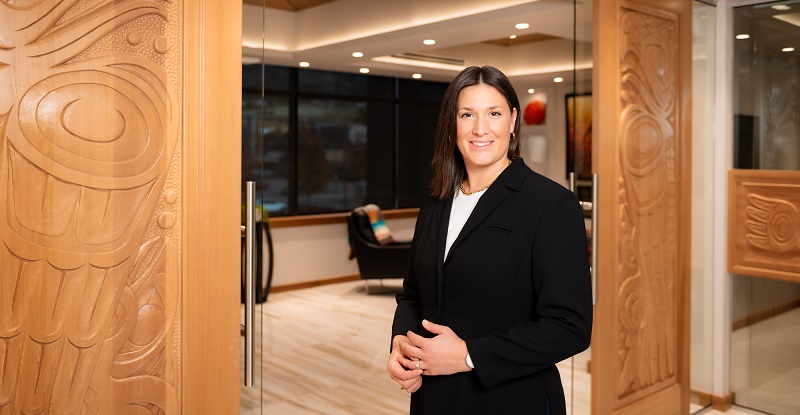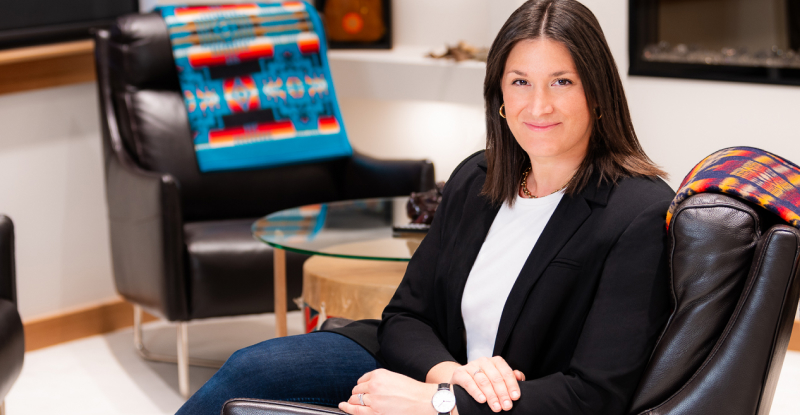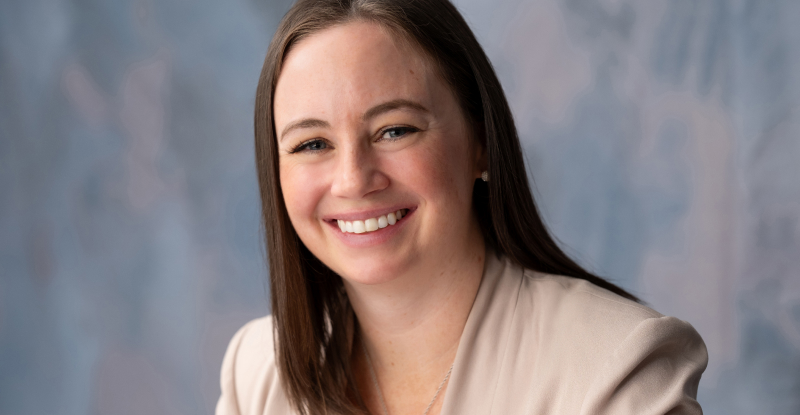
In this podcast episode, Rachel McAllister, CPA, CA, CFO at First Nations Finance Authority, speaks with Leah Giesbrecht, a communications specialist at CPABC. Part of our Coffee Chats with CPABC podcast series.
More and more, Indigenous communities are working with Indigenous-led organizations to finance major initiatives to grow and improve quality of life in their communities, including infrastructure, housing, and commercial projects. In fact, this area of financing has seen a number of landmarks including in January 2024, when the First Nations Finance Authority (FNFA) surpassed a $2 billion milestone in financing to First Nations governments.
Someone helping to lead this work is Rachel McAllister, CPA, CA. Rachel is CFO at FNFA, a national non-profit that provides First Nation governments with access to financing, investment, and advisory services, located in Westbank First Nation, BC. We recently chatted about how FNFA is working with nations across Canada on community-led projects that drive prosperity, FNFA’s efforts to close an estimated $350 billion infrastructure gap, and how the ability to pivot is essential to her work.
 To start off, could you share a little bit about your career journey?
To start off, could you share a little bit about your career journey?
Rachel: I wasn’t someone who knew what I wanted to do right out of high school. I went to university to study business because it seemed like that would give me the most options and finance and accounting were the areas that I was most interested in. Overall, my CPA designation opened a lot of doors and gave me the flexibility to try different things. After graduating, I worked with KPMG for five years, became a manager and FNFA was one of my clients. At that point, they were just starting to make headway, and as the organization grew, they saw the need to have more CPAs on staff. I was approached to work as their finance officer and that grew into becoming the financial controller and now the CFO - a role I’ve been in for the last seven years.
FNFA was created to give First Nations the same financing opportunities as their municipal counterparts. When municipalities need to improve infrastructure like roads or water services, they borrow from a provincial municipal finance authority that provides access to lower-rate, longer-term financing. Since First Nations are under federal jurisdiction, they couldn’t access this type of financing, so FNFA was established.
FNFA’s mission statement is ‘helping First Nation communities build their own future on their own terms.’ Against that backdrop, what makes you feel passionate about working where you do?
Rachel: It’s hard to pinpoint one thing. What FNFA does might just seem like financing, but it’s financing at rates that can make projects economically viable and more profitable. It creates a situation where First Nation projects, whether economic development or infrastructure, are financed at the lowest rates possible to minimize the financial burden on the nation. This provides much-needed infrastructure in our communities to start closing the infrastructure gap that exists between Indigenous communities and the rest of Canada. This gap is huge - a recent study estimated that it will take about $350 billion to close the gap and ensure that on-reserve communities have access to similar infrastructure as the rest of the country.
Each year at FNFA’s annual general meeting, we invite members to present on their projects that we’ve financed and tell their stories of what these projects have meant to their communities. For example, a nation in Saskatchewan built a high school - this meant their youth could stay in the community for their entire primary and secondary education and continue to have cultural learnings that weren’t available when they had to bus 45 minutes to the closest municipality for school. These types of projects help communities retain their members, grow their culture, and reclaim their identity.
We also have quite a few projects in BC. We recently partnered with the Ch’íyáqtel First Nation near Chilliwack and BC Housing to build residences that provide for different needs. What does this look like? This is multiple families that were living in one small dwelling who now have their own homes. This is parents with small children who finally have their own home. This is Elders having homes in their community so they can attend community events which was not possible for some due to mobility issues.

As CFO, your responsibilities include oversight of the financial analysis of FNFA’s members, reporting to the board, working to achieve investment goals, reporting oversight, and FNFA’s accounting. Is there a particular skill that you draw on to do all this?
Rachel: The ability to be agile and to pivot. Part of that is having good time management skills, the ability to not be overwhelmed, and the ability to utilize your team. Since we operate across the country and the regulatory and legislative environments are always shifting, my team is constantly looking ahead and planning for change. We also consider what changes might look like for all our different stakeholders. When I was looking at where to take my career outside of public practice, I wanted to be in an environment that was different and interesting all the time, and I definitely have that.
As a leader in a constantly changing environment like ours, I focus on being approachable, a team player, and valuing my team’s input. Because I’m not involved in the details every day, their input helps me make sound decisions.
Is there an initiative you're currently involved with that’s particularly impactful?
Rachel: The federal government has a goal to close the infrastructure gap between Indigenous communities and the rest of Canada by 2030, and FNFA has been supporting this. For example, we are looking to change the way the federal government funds infrastructure projects. Currently, they have an amount budgeted to build a certain number of houses, schools, etc. in Indigenous communities each year. But because Indigenous communities have the largest population growth in Canada, the infrastructure gap continues to grow year over year. FNFA is looking to use the federally annual budgeted infrastructure dollars to finance these assets over the longer term - that is, building more assets now for the future. We can build more at today’s dollars and start making some headway in that infrastructure gap. This could include replacing diesel power in remote communities with clean energy, providing clean water, building housing that's up to par with the rest of Canada, improving roadways - the list goes on.

Recently, there have been a number of milestones in First Nations financing for community infrastructure and economic development projects. What’s your perspective on these events?
Rachel: When FNFA began, we saw a lot of infrastructure-specific projects and now we’re seeing more economic development projects. These projects provide income for nations to not only prosper financially but self-fund infrastructure needs, so it’s a full-circle opportunity. More nations are also participating in large projects throughout their territories - wind farms, equity participation in a variety of project, and so on. We’re also seeing a focus on economic reconciliation with the private sector partnering with Indigenous communities that typically neighbour potential project sites and structuring initiatives for Indigenous-led projects.
Indigenous peoples, as part of their culture, are stewards of the land, so seeing them included and able to prosper from once-in-a-generation opportunities is invaluable. Indigenous peoples have a perspective of wanting prosperity for the next seven generations. A lot of these projects are done with the mindset to create sustainability for their communities to continue to prosper for generations to come.
Any other trends you’re seeing in First Nations financing?
Rachel: With the adoption of the United Nations Declaration on the Rights of Indigenous Peoples and increased focus on economic reconciliation, we’re seeing more agreements with First Nation groups and changes to how these agreements are structured. Another trend is First Nation communities working together on larger projects. In 2021, the Mi’kmaq Coalition, which consists of seven nations, acquired a 50 percent share in Clearwater Seafoods - the single largest investment in the seafood industry by any First Nation group in Canada. The Mi’kmaq Coalition includes nations that are large and prosperous, as well as smaller nations. By working together, these seven nations are also helping neighboring nations bring up the level of their economies. This way of working allows them to participate in further projects, further building of their communities, further prosperity for future generations.

Finally, is there a piece of advice you’d give to CPAs looking to succeed in the C-suite?
Rachel: Ultimately, soft skills really help you succeed. Of course, the technical and critical thinking skills you learn as a CPA are super important, as is the ability to see the bigger picture and to look toward the future. Collaboration, communication, and adaptability - those things make you a well-rounded professional who can lead.
All photos courtesy of Michael & SuZanne Hintringer Photography.
Leah Giesbrecht is a communications specialist at CPABC.



